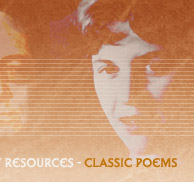|
Edward Thomas is buried in Agny Military Cemetery, France, Europe. (Row C, Grave 43.)

The Grave of Edward Thomas
Thomas was
born in London in 1878 - the eldest son of Welsh parents. He was
educated at St Paul's School in London, where he won a scholarship to Lincoln
College Oxford. While a student at Oxford he met and married Helen Noble
and the first of their three children, Merfyn, was born while Thomas was
still an undergraduate. On leaving Oxford, Thomas was determined to
support his family by writing and so he embarked on an arduous period of
prose writing which included: journalism, topographical books and
essays. He also undertook biographies of Keats, Swinburne and the
writer and naturalist Richard Jefferies. In 1914
Thomas was introduced to the American poet Robert Frost who encouraged him to write
poetry. Thomas and Frost were part of a group of poets who were living
together in the Gloucestershire village of Dymock just before the
outbreak of the first world war. (See Dymock Poets.)
In 1915 Thomas joined the Artist's Rifles and while stationed at Hare
Hall Camp in Essex he wrote many of his finest poems. (Wilfred
Owen joined the Artist's Rifles two months later.) Thomas' unit
reached Flanders in early 1917 and he was killed on
Easter Monday (April 9th) on the first day of the Battle of Arras.
He was standing next to the Beaurains Observation Post when a shell
exploded near by.
With the
exception of six poems published under the pseudonym Edward Eastaway, none of
his
poetry was published before his death. Like his friend Frost, Thomas'
poetry
employed a simple, understated style which relied heavily upon natural
speech patterns.
|







